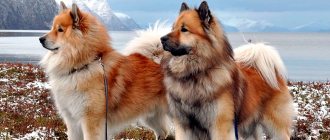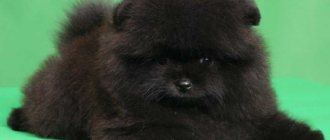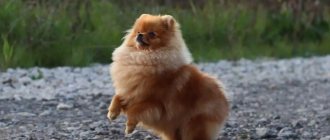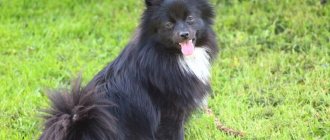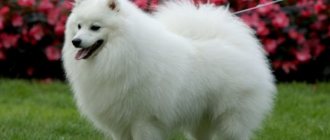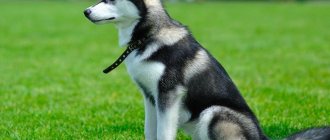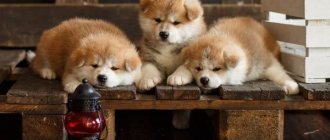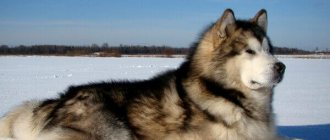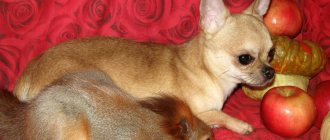Like any other dog living with a person, the German Spitz needs special education. The level of comfort in the house and the state of psychological and verbal communication between man and dog depend on how your four-legged friend is trained and how he is brought up. Considering the fact that dogs of this breed in most cases live in city apartments, the behavior of the German Spitz determines the level of relationships between the animal and the people around it.
Despite the fact that the breed is clearly not a service breed, in order for a fluffy and funny puppy to grow into a well-mannered and obedient dog, daily lessons, training and training will be required. For those who are faced with a similar problem for the first time and do not know how to raise a German Spitz, it’s time to seek advice and help from professional dog handlers. Experts will always tell you where to start the training process, taking into account the nature and characteristics of the breed, they will select the necessary methodology for subsequent training.
Pedigree puppies from breeders or in a nursery cost approximately the same. If you are offered to buy a dog cheaply, you should treat this offer with extreme caution. In such cases, there is always a high probability that you will be deceived regarding the purebred condition of the animal, or you will be offered a dog with congenital defects.
Characteristics and description of the breed
What does it look like
The parameters of this dog breed range from 23 to 29 centimeters at the withers, and their body weight ranges from 4 to 9 kilograms. The ratio of the length of the dog’s body and its height is one to one. Therefore, at the first quick glance, the small Spitz resembles a square ball of fluff. A German micro Spitz is considered an adult at 2 years of age.
The miniature Kleinspitz has a harmonious physique, all parts of the body smoothly blend into each other. And the thick and shiny coat owes its appearance to straight and coarse guard hair and downy undercoat.
Head, ears, nose
The head of the miniature Kleinspitz is wedge-shaped. By itself it is small in size. The ears are erect, in the shape of a triangle.
The orange nose is round and small. Most varieties of coat color have a black lobe, while cream and brown representatives have a brown lobe.
Jaws, teeth
The dog has a scissor bite, both jaws are developed and have a full row of teeth.
By eight months, the Pomeranian's permanent dentition is finally formed. There are normally 42 teeth in total (20 on top, 22 on bottom).
Eyes
The eyes of the little orange are oval. All color types have dark irises.
Neck and torso
The dog's neck is of medium length and gradually widens from top to bottom. The withers are well defined. A striking feature of the Pomeranian is the lush “collar” around the neck.
The back is straight, the stomach is tucked, and the chest is deep and developed.
Tail and limbs
The Kleinspitz's tail is medium in length and has an even length of hair over its entire surface. The tail lies on the back, there are also curls (both one and two).
The paws of the small Spitz are clearly muscular and set wide apart. The fingers are compressed into a ball and have hard black pads.
Coat color
Black
The black color is a unique feature of the Miniature Pomeranian. The fact is that it is rare to get a puppy of this color. Black wool always implies black skin color. Typically, puppies are not born with a pronounced charcoal color, but have brown fur.
Black and Tan
Black and tan means there are two colors in the Pomeranian's coat: black and another, lighter shade. Often the second color is sable or orange. Black, as a base, covers most of the dog's body. The second color is observed on the head, limbs and chest.
White
A truly aristocratic color, which is inherited by a small puppy from its father or mother. These babies are called “leucistic,” which means partial albinism. According to the standard, white wool should not be interspersed with other shades.
White Pomeranians usually have brightly colored noses, eyelids and lips.
Cream
Once a small baby is born, it is impossible to recognize the cream color of its coat. The cream color will become visible only after the first molt. For example, if at 5 months a cute Spitz is snow-white or beige, then after changing its coat it will become creamy.
Cream color, in turn, can be rich (warm) and cold. The latter is sometimes difficult to distinguish from snow-white wool.
Ginger
This is the most common and famous color of the miniature orange in the world. Red Spitz can be either bright red or more close to beige.
Sable
This color combines two shades. With it, the guard hair has a heterogeneous color: at the base it is light, and towards the tip it becomes dark. This creates an iridescent effect on the fur. Sable color comes in the following subspecies: gray, cream, red or orange sable.
Orange
This is a variety of red color, characterized by rich color. Orange dogs have brighter, richer fur. To understand whether a puppy will grow up orange, you need to pay attention to its ears. If they are bright orange, then with a high probability the baby will acquire the same color after the first molt.
Paticolor
This color of the miniature orange is characterized by the presence of two tones: the main one and the additional one. The main color in all cases is white. The inclusions come in different colors, for example, black, brown or orange. Black and white orange is common.
The paticolor color is considered the standard color when specks of an additional color cover the dog evenly and symmetrically.
Types of small German Spitz
The Miniature Kleinspitz is a super-mini dog breed. This is a subspecies of the German Spitz breed. It is very similar to the Pomeranian, but is considered an independent variety. Another variety of German Spitz is the Grossspitz. The weight of a Gross Spitz boy can reach 22 kilograms.
Character and behavior of the dog
The character traits that the Small German Spitz is known for are:
- The desire to be a leader. When a minik gets into a new home, it quickly gets used to and adapts there. And that’s when active attempts to show leadership begin. Methods of influence include complaints, manipulation and tricks. It is important to promptly let your pet understand that such behavior is unacceptable. It is necessary to stop the attempts of the four-legged creature to “set the tone.” It is necessary for him to understand the following: the owner must be respected and obeyed. There is no need to be afraid to say “No” strictly.
- Attachment to the owner. So strong that the pet does not leave the person for a second. A devoted companion will do his best to adapt to the comfortable lifestyle of the owner.
- Excessive playfulness. Small children like this quality: the dog entertains and makes them happy.
- Distrust of strangers and animals. The alertness of the miniature German Spitz is often manifested by a piercing loud bark. Therefore, it is necessary to wean the little Pomeranian from barking without a reason even in childhood.
Intelligence
The intelligence of the German Spitz is amazing. This is a smart dog with a high learning rate.
Character of the German Spitz
These small animals, which are characterized by high mobility, were the favorite animals of many geniuses and emperors, such as Michelangelo Buanarroti, Catherine II, Mozart, etc.
Most likely, such high popularity is connected not so much with beauty, but also with the fact that these animals are able to empathize, are ready to protect their owner at the cost of their lives and be faithful to him until the end of their lives.
Very important! The German Spitz is considered a dog that can become a true companion, so it is difficult to bear separation from its owner. The dog is ready to endure any hardships and hardships, just to always be by his side. He is ready to protect his master at any moment, regardless of the size and nature of the impending danger.
If it is a large dog, this fact will not frighten the German Spitz.
Despite its size, the dog barks very loudly, although if desired, the pet can be quickly weaned from this habit, which is very inconvenient for neighbors. These dogs quickly understand what their owner wants from them.
The health and well-being of a pet depends on many factors, but most importantly, the owner must provide it with physical activity, for which the animal must be often walked and involved in outdoor games.
When walking outside, it is better to keep your Spitz on a leash. The dog is quite curious, so it can easily fall under the wheels of vehicles.
Differences between male and female
The gender of a Miniature German Spitz affects the dog's appearance and personality. For example, boys have the following:
- larger body;
- very fluffy and thick coat;
- Shedding is easier because less hair is lost;
- increased emotionality;
- They are almost incapable of cunning and manipulation.
But for a German Spitz Minik girl the following is characteristic:
- cleanliness;
- more balanced, calm character;
- the ability to manipulate and deceive;
- less expressed emotionality;
- frequent long-term shedding: before estrus, after childbirth.
But regardless of whether it is a girl or a boy, the pet will be devoted to its owner to the last, like a child.
How to choose a puppy
Puppies are divided into classes: pet, breed and show. When choosing, it is important to determine the gender of the future pet. Boys look more impressive and attractive, but they are stubborn and difficult to train. The girl is more flexible and calm, attached to her owner.
The puppy is chosen to be active, clean, with dark eyes. The fur should be straight and thick, the tail should be like a pretzel (fitting to the back). Pigmentation of the mouth to match the color.
When choosing a name for your baby, you should take into account that he will quickly remember a sonorous, short nickname. The most successful nicknames for males are Bimbo, Jack, Bruno, for females - Musya, Angie, Zhuzha.
Care and education of the little orange
Eye and ear care
Eye and ear care measures include the following procedures:
- Clearing the eyes of accumulated secretions. To do this, you need cotton pads and warm water, or chamomile decoction. If redness is visible, you need to wipe with brewed strong tea.
- Cleaning the ears from wax. Again, you need a cotton pad or swab. They usually clean them with special lotions for the ears, but you can use calendula tincture or boric alcohol.
Tooth and nail care
Most dog breeds are prone to dental problems. Among them are the formation of tartar, stomatitis, caries and even periodontal disease. Therefore, dental care consists of the following:
- Every day, use a soft toothbrush and dog toothpaste to clean your small pet's teeth.
- You need to buy your dog a special dental stick. By chewing it, he additionally protects his teeth from plaque.
As for the claws, they will need to be trimmed only when they significantly interfere with the pet when walking and do not grind down on their own. Haircuts are given both in salons and at home. To carry out a haircut at home, you need to purchase a nail clipper. You need to cut off the transparent part of the claw, which is empty inside.
Grooming
Caring for the impeccable coat of a German mini Spitz includes grooming, that is, cutting and periodic washing. More about all this later in the article.
Proper nutrition
How a small pet eats directly determines its health and life expectancy. You can feed oranges with prepared food and natural products.
When feeding your dog dry food, you must follow the following rules:
- The food class should not be lower than premium. Ideal – holistic.
- The food must be free of chemical additives and preservatives.
- Dry granules should completely cover the dog’s need for microelements and vitamins.
- You need to create a feeding regimen and not deviate from it. It is enough to feed an adult Small German Spitz twice a day.
- There must be clean boiled water next to the bowl. Change it daily, and if necessary, several times a day.
If your miniature pet is on a natural diet, you need to know the peculiarities of such nutrition. Important rules for feeding natural food to a German Spitz are as follows:
- balance: proteins in a proper diet are at least 70 percent. Proteins mean meat and meat by-products, fermented milk products (mainly kefir and cottage cheese). The rest comes from cereals and vegetables;
- the pet should not overeat;
- You should not give your Pomeranian food from the owner’s usual table. After all, it is rich in salt, seasonings and sugar. This is all harmful for your four-legged friend and will cause him big health problems;
- you need to cook every day, that is, food prepared for oranges must be fresh and warm;
- maintaining a balance of vitamins and minerals. It is recommended to buy your dog a special vitamin complex;
- We must not forget about clean drinking water and ensure free access to it.
Hygiene procedures
Pomeranians should only be washed in the bathroom if necessary. You need to bathe your baby as little as possible, otherwise the condition of his skin and fur will noticeably deteriorate.
If your little pet gets dirty or returns home after a walk in the heat, it is better to use dry dog shampoo.
Pomeranian grooming, molting
Grooming is the most important procedure for a small German Spitz. It is needed not only to give the mini a well-groomed look, but also for:
- removing excess hair, which is an excellent breeding ground for bacteria;
- ridding your pet of matted tufts of fur that cannot be untangled by hand;
- eliminating the risk of the spread of ticks, fleas and other parasites living on the skin.
If the owner does not take the miniature pet to shows, the haircut can be done at home. It's quite easy to learn. It is permissible to cut a German Spitz for the first time only after shedding has completed, i.e. after nine months of age.
The following recommendations will help you groom your German Mini Spitz at home:
- Preparation for grooming means thoroughly combing your pet's fur. You need to take a comb with sparse teeth and start combing against the grain. Especially treat the groin and axillary areas, the hair between the toes;
- To prevent the wool from generating static electricity during combing, antistatic agents must be used;
- After the combing procedure is completed, you need to bathe the dog and wash him with dog shampoo. After bathing, pat the coat dry with a towel rather than rubbing it. Finally, dry the coat with a hairdryer;
- You will need straight scissors with sharp blades, as well as a comb with long teeth. Additionally, it is allowed to use thinning scissors;
- For the haircut itself, a machine is also suitable.
The first shedding of the Small German Spitz begins between three and nine months. Some miniature German Spitz dogs begin shedding at 10 months. During this period, the little puppy loses its baby fluff and acquires an adult coat. During the first molt, you need to brush your baby often: this will help him get rid of old fluff faster. If molting began early, then at 4 months the German baby will be almost bald.
The second shedding of the Small German Spitz begins at the age of one year. At this moment, the dog finally changes its undercoat.
Subsequent molts of the minik occur in spring and autumn. Sometimes they begin to shed in hot summers due to temperature changes.
The final coat change occurs at 1.5 years. At this age, the small animal becomes fully mature. The wool already consists of two layers - the undercoat and the layer of guard hairs.
The Small German Mini Spitz's coat continues to grow until it is three years old. And only then will the pet’s final rich coat be formed.
Training, raising a dog
Any dog without proper training will behave willfully. This also applies to the miniature German Kleinspitz. This breed is known for its energy and intelligence. Therefore, it is necessary to direct this energy in a timely manner in the right direction.
Minik training begins from puppyhood. The Pomeranian must understand that the owner must be obeyed, that the authority in the house is the person, not the dog. At first, education is aimed at suppressing the desire of the Pomeranian to dominate everywhere and over everyone.
The goals of raising a grown-up German puppy are:
- accustoming to the surrounding world and society, the ability to behave in public;
- ridding the baby of jealousy and aggression;
- learning to express emotions more restrained.
When the owner finds a common language with the little German Spitz, it’s time to start training. Basic commands that dogs are taught include:
- "Ugh".
- "Sit".
- "Aport."
- "To me".
After mastering the basic skills, you can begin to learn complex commands and actions. The Small German Spitz is an incredibly smart breed. Minik is capable of performing interesting acrobatic tricks and even performing magic.
How does pregnancy and childbirth proceed?
Knitting a small German Spitz is allowed after the physiological formation of the dog is completed. For girls it ends at 15 months, for boys at 12. A female must go through at least two heats before her first mating. You cannot breed during your first heat.
Rules for breeding miniature Kleinspitz:
- First of all, you need to make sure that both dogs are healthy;
- choose a partner of the same size;
- A female should not give birth more than once every two years. This is a huge burden on her body. The girl needs to recover after pregnancy.
Caring for a pregnant miniature German female takes a lot of time. And important changes concern the dog’s diet. The number of feedings increases to three times a day.
To prepare for childbirth you will need:
- disinfect the room where the dog will give birth;
- show the female this place, let her get used to it;
- you need to prepare cotton diapers, napkins, medicines and treated scissors;
- Find out the phone number of the veterinary hospital so that in case of emergency you can call a specialist for help.
Before giving birth, the female's behavior changes, so it is impossible to miss this moment. During childbirth, you do not need to leave the female; you should always be ready to provide first aid. It is necessary to talk gently to the dog and give it words of encouragement.
Usually, the female mini-Kleinspitz herself gnaws the umbilical cord of a newborn puppy. But in some situations she needs human help.
After the birth of each puppy, the placenta comes out. You need to make sure that their number matches the number of puppies. The labor of a German Kleinspitz lasts up to four hours.
Health, frequent illnesses
German Mini Spitz dogs usually do not have serious health problems and are not prone to hereditary diseases. However, in these individuals with the following developmental features, the risk of disease increases slightly:
- malocclusion;
- dense skull bones;
- bulging eyes;
- non-standard color;
- deviations in the structure of the respiratory system.
The listed developmental features of the small German Kleinspitz often lead to the following diseases and abnormalities:
- hypothyroidism and other disorders of the thyroid gland;
- dental problems: tartar, periodontal disease, caries, etc.;
- respiratory tract diseases;
- snore;
- hip dysplasia;
- eye diseases, increased lacrimation.
But there are also problems that are typical for all German Spitz:
- tendency to allergies. It often manifests itself as a skin reaction;
- tendency to obesity. Overfeeding will quickly lead to weight gain. As a result, metabolism is disrupted and serious consequences occur.
Keeping a German Spitz at home
These pets have a fairly friendly character, and the dog detects any changes in the mood of both the owner and the rest of the family.
A Spitz, without speaking, can stay close to its owner for a long time if he is resting. This breed is especially popular among children, since the dog is more like a soft toy that you want to pick up and play with. To avoid any problems, children must be taught how to properly handle such a pet: do not pull the tail, do not grab the limbs, etc.
German Spitz are quite easy to train, which indicates their high level of intelligence. They easily master not only basic commands, but also various tricks. The training process should not be accompanied by screaming or punishment, as this can disrupt the psyche of the pet.
These are sociable and inquisitive animals that are able to find a common language with any pets, although it is known how wary cats are towards dogs and vice versa.
Advantages and disadvantages of Kleinspitz
Advantages of the German Spitz:
- Sociability, friendliness. Thanks to these qualities, the minik will quickly get used to a new home and a new family.
- Wits and intelligence. The breed is well trained and quickly remembers commands.
- A small German Spitz can be trained to go to the toilet at home. For this you only need a tray.
- Compactness. It is convenient to take your pet with you. After all, the dimensions of the German mini-Spitz are 23-29 cm at the withers.
- Tolerates changes in climatic conditions, temperature and cold changes well.
The relative disadvantages of the German Kleinspitz include the following:
- The need for careful coat care, especially during shedding.
- The next disadvantage follows from the previous one - the ability to cause allergies.
- If there is a lack of upbringing, the pet will chase other people's animals and get into fights with them.
- Touchiness. This baby can harbor a big grudge against its owner.
- Jealousy. The miniature German Kleinspitz will not allow its owner to communicate with anyone else. A person is his property.
- Inability to be alone. Otherwise, the apartment will be seriously damaged.
- Loud barking. An ill-mannered pet will bark for every reason.
Origin story
It is believed that Spitz dogs come from the turf dog depicted on household items from the times of Ancient Greece and Ancient Rome. Initially, they were kept by commoners as guards (they ate less than large breeds, but were no worse guarded). The 18th century is considered the beginning of the history of the breed, which aristocrats became interested in.
In the 19th century, the small German Spitz was recognized as particularly popular; artists depicted it in paintings. He was loved by such great people as Mozart, Empress Catherine and others. In the 18th century, this breed began to be bred in Germany. In 1891, the English Spitz Club appeared and a standard for the Pomeranian breed was developed. The dog takes part in dog shows.
At the end of the 19th century, Spitz dogs were brought to the United States, where they were given the name Eskimo and began to be bred. The white German Spitz was especially popular. In the modern world, American ones are recognized as the best. The breed was divided into two weight categories: up to 2.5 kg and more.
In 1900, the German Spitz club appeared in Frankfurt am Main, where a stud book was created. Medium-sized dogs were bred in France. In Denmark and the Netherlands, dogs lived on barges and exterminated rodents. At the beginning of the 20th century, the breed was already divided into 3 groups (by size): large (45 cm), medium (38 cm) and mini dwarf (25 cm).
At the end of the 19th century, the breed was brought to Russia. Dogs were a sign of bourgeois luxury, so only wealthy people had them. And although dogs participated in exhibitions at the beginning of the 20th century, they later lost their popularity. In the 21st century, the breed is coming back into fashion and is being brought back to the country.
Peculiarities
The Small Spitz has a cheerful and mischievous disposition, loves to play and can frolic throughout the day. He is inquisitive and interested in everything around him. Despite its size, the Spitz is an excellent guard, thanks to its acute hearing. The baby is patient and allows even the smallest children to play with him. Only if he is hurt is the dog able to snap back or show aggression. The Spitz is very emotional, loves attention and affection, quickly grasps all commands on the fly and is easy to educate and train.
The dog does not tolerate loneliness well and it is better not to leave him alone for a long time. It is advisable to start socialization as early as possible, as the dog may be intimidated or afraid of loud noises and other things. Animals show caution towards strangers, but without aggression. The Spitz easily gets along with absolutely all pets: cats, dogs, rodents, birds. Their devotion to their loved one is enormous: the dog becomes very attached and has difficulty withstanding a change of owner.
Jealousy is inherent in kids: it is important for them to have a lot of attention and affection, otherwise selfishness breaks through in their character. If Spitz dogs don’t like something, they will openly tell everyone about it, even in front of strangers - loud and ringing barking should be taken into account when choosing a puppy for an apartment.
brief information
- Country of origin: Germany
- Height: Depends on variety:
Dwarf – 21 cm
Kleinspitz (small) – 27 cm
Mittelspitz (medium) – 35 cm
Grossspitz (large) - 45 cm
Wolfspitz – 49 cm
- Weight: Depends on the variety:
Dwarf – up to 3.5 kg
Kleinspitz (small) – 3-6 kg
Mittelspitz (medium) – up to 11 kg
Grossspitz (large) - up to 12 kg
Wolfspitz – up to 28 kg
- Life expectancy: up to 16 years
Where are you from?
By the name of the breed, you can determine the homeland of origin of this dog, so beloved by the inhabitants of our country.
In the 10th century, during the raids of the Scandinavian Vikings on Central Europe, Spitz began to explore the coast of the Baltic Sea. The inhabitants of Europe were happy with these fluffy dogs, because their sensitivity, unpretentiousness and caution were useful to the peasants for protecting their yard and home. Smaller individuals remained without the right to their home and continued to seek refuge throughout Europe until they were noticed by rich Frau. Such a simple maneuver - to please the ladies - allowed Spitz dogs to move from peasant households to the silk pillows of ladies' boudoirs.
The Thirteen Years' War (1618-1648) allowed small Spitz dogs to colonize the British Isles. The royal hounds began to select the smallest representatives of these dogs. This selection made it possible to obtain crumbs weighing two kilograms. Such miniature dogs became favorite toys for the royal palace.
At the same time, larger representatives of these individuals served on ships and barges. Their task was to catch rats and mice and preserve food supplies for the sailors.
The modern appearance of this breed was preserved in Germany, and in 1899 breeders founded a club for fans of this breed, and already in 1906 a standard was approved according to which dogs are given a pedigree.
The official name Pomeranian is adopted for the mini Spitz of English origin. The translation of “orange Spitz” sounds like “orange Spitz” - this name applies to all Spitz, and not just to dogs with a bright red coat. A distinctive feature of their color is their red fur; the dog looks like a bright orange orange!
Photo of a two month old puppy
In Russia, it is not customary to divide Pomeranian and German Spitz into two breeds; they are often mixed with each other, which has led to difficulties in determining the type of dog; they are often called in general German, and Miniks - Pomeranian.
Multicolored miracle
The characteristics of the description of Spitz dogs of the small group also include their colors. Few breeds can boast such a variety of coat colors.
Breeders have bred many color variations of Spitz dogs. However, the FCI standard adopted pure black, zone-gray, pure white, white-red, cream, red and brown colors of varying intensity. Three-color coat colors are also allowed, when spots of the above shades are evenly distributed on the main white background.
From security guards to lap dogs
The study of the remains of lake and turf dogs found in central Europe gave reason to consider these animals as the ancestors of modern Spitz. It is believed that this breed has been around for 2,500 years. The first mentions of these dogs can be found in manuscripts of the fifteenth century. Ancient descriptions indicate that over time their exterior has not undergone major changes.
Initially, Spitz dogs were used as guards for sheep herds and household property. They also scared away and caught small rodents. Mostly these dogs were kept by ordinary people. The situation did not change until the upper strata of society noticed the loudly barking but very beautiful dogs. The nobility wanted to keep the Spitz with them and made them pets.
In the eighteenth century, German breeders, and then breeders from other countries, intensively set about breeding smaller representatives of the breed and obtaining different shades of wool from them. This is how five varieties of the breed appeared.
Little ringing defender
Instincts from the past and excellent hearing make small Spitz dogs excellent watchdogs. Their vigilant, wary and confident nature allows them to be the first to notice strangers and announce their approach with a ringing bark.
But it is barking that can become a stumbling block in communicating with a Spitz. Every time the dog will react loudly to any irritant, which can infuriate even the most patient owner. Therefore, many consider these pets to be intrusive and obnoxious.
Being suspicious, these dogs do not favor either guests or the owner's friends. With good upbringing, they will not rush at them, they will just stand in the way, because such dogs do not lack courage. Whether this is arrogance or a manifestation of devotion and protection is up to the owner to decide.
Square fluffy ball
It is easy to recognize the German Spitz dog breed by its small fox-like muzzle, triangular and high-standing ears, thick and fluffy hair and a ring-shaped tail. The average Spitz has a slightly longer muzzle than the small and miniature ones.
The animal's body resembles a square in its proportions: its length is equal to the height at the withers. Short but muscular legs allow the dog to move freely, plastically, springily pushing off the ground. It seems that she is not running, but hovering above the ground. The playful look of almond-shaped eyes always invites you to play or run.
The dog's jaws have a scissor or pincer bite. It is worth noting that the dental system is a sore subject for Spitz dogs. Due to poor breeding, animals may inherit undershot, undershot or fragile teeth.
